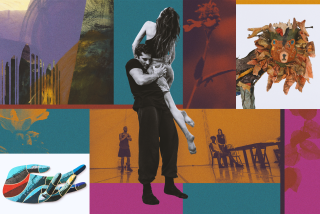Pina Bauschâs Postcards of the West
WUPPERTAL, Germany â Only the blooming chestnut trees proclaimed that spring nominally had arrived in this gray and fog-shrouded city 25 miles east of Cologne. But the dreary weather did not dampen the enthusiasm of Pina Bauschâs Saturday night audience who, judging from the license plates in the parking lot of the Wuppertal Schauspielhaus, had arrived from all over Germany, as well as Holland, Belgium, France and Luxembourg. They had come for the first of a series of preview performances of âNur Duâ (Only You), choreographer Bauschâs newest dance-theater piece, inspired by a three-week residency in Los Angeles last February, as well as short visits to Berkeley; Austin, Texas; and Tempe, Ariz.
âNur Duâ will receive its American premiere Oct. 3 in Berkeley and then play the Dorothy Chandler Pavilion Oct. 10-12 before traveling to Austin and Tempe. The work is the result of the first-ever co-commissioning project by six Western arts presenters: Cal Performances at UC Berkeley, UCLAâs Center for the Performing Arts, James Doolittleâs Southern California Theatre Assn., the Music Center of Los Angeles County, the University of Texas Performing Arts Center and Arizona State University Public Events. The $1.2-million project allowed the choreographer to gather her impressions of life in the American West, which form the basis of the new piece.
Images in âNur Duâ clearly have been inspired by locations Bausch visited for this first site-inspired work created outside Europe.
First to greet the audience from the open-stage, 750-seat Wuppertal theater is a set of six gigantic redwood tree trunks, plus one stump whose roots stretched like fingers across the floor. A wound-like cutout on one of the trunks, some 15 feet above the ground, became the temporary abode for one of the performers. This image of home is but one of several that reoccur throughout the evening: A tiny Victorian mansion gets carefully set up and then set afire. A gated community of paper houses is established and casually knocked down, only to be resurrected again. A woman creates a living room from toy furniture she pulls out of a suitcase.
âNur Duâ consists of dozens of such incidents and images, some only a few seconds long, others quite substantial and involving the whole 24-member company. Twice, extra men are brought in for sequences in which 30 of them iron their shirts on top of cardboard boxes, and in another, polish their shoes. Since the work is constructed in a nonlinear fashion, many of the individual scenes at first seem random and unrelated. Some pass by like a fleeting thought, others begin to acquire meaning through accumulation and hindsight understanding.
Plastic is everywhere, people shower in it or are wrapped in it as gift packages. They relax or party even as the earth rolls and shakes under them. A bouncy cheerleader almost jumps out of her skin. Solos sizzle with the energy that Bausch observed on her nightly forays into the Los Angeles club scene. A Virgen de Guadalupe poster sports a manâs face. Hooker angels lose their wings. Small water bottles are omnipresent. A hairdresser, in white fox and rhinestone jewelry, gives identical hairdos to women, while a singer croons âOnly You.â
Those familiar with Bauschâs work--her company last appeared in Los Angeles in 1984 during the Olympic Arts Festival--will recognize certain trademarks--women in stiletto heels and slips or sleeveless ball gowns whose hems tend to hike up and tops to slide down; characters who range from the catatonic to the hysterical; displays of multilayered and contradictory emotions; movements that encompass the minimally gestural as well as the frenzied and highly technical.
Music in âNur Duâ encompasses the spectrum of radio airplay--from rhythm and blues to jazz, â50s-style crooning, New Age, Latin jazz and Latin pop. The last song you hear is a Portuguese fado whose lyrics end with: âWe only need two things: hope in our fate and someone who loves us.â
Saturdayâs performance of âNur Duâ ran slightly more than three hours, and Bausch considers it a work in progress with major revisions expected between now and October. As she explained in a post-performance interview: âWhen I see it from the front [of the house], I have a much better idea of what it looks like.â
The in-progress version of âNur Duâ was greeted with great enthusiasm by this audience of Bausch aficionados. The work received a standing ovation and six curtain calls, and German critics also expressed their approval though not without some reservations. âThe America of âNur Duâ is amusing, flat and colorful but without depth,â said the Frankfurter Allgemeine. âThe material is rich and imaginative, but the proportions donât yet work.â The Suddeutsche Zeitung from Munich described âNur Duâ as a âgigantic collection of materialâ that âneeds to be tightened and cut by about an hour.â
Rheinische Post of Cologne was most enthusiastic, calling the work âportraits of longingâ that Bauschâs âfabulous sense of timingâ ties together âas if with a loosely knotted ribbon.â
More to Read
The biggest entertainment stories
Get our big stories about Hollywood, film, television, music, arts, culture and more right in your inbox as soon as they publish.
You may occasionally receive promotional content from the Los Angeles Times.










